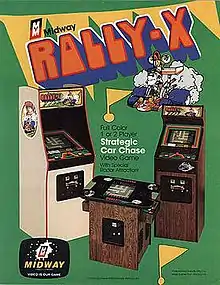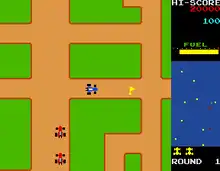Rally-X
Rally-X[lower-alpha 1] is a 1980 maze chase arcade game developed and published by Namco. The player controls a blue racecar that must collect all of the yellow flags in each stage, while avoiding red enemy cars and rocks. A radar is displayed at the right of the screen, showing the location of the player, remaining flags and enemies, alongside a fuel meter that gradually depletes as the stage progresses. Enemy cars can be stunned by releasing smoke screens, which will deplete the fuel meter.
| Rally-X | |
|---|---|
 Advertising flyer | |
| Developer(s) | Namco |
| Publisher(s) |
|
| Designer(s) | Hirohito Ito[1] Kouichi Tashiro[1] |
| Programmer(s) | Kazuo Kurosu[1] |
| Composer(s) | Toshio Kai[1] |
| Series | Rally-X |
| Platform(s) | Arcade, MSX, Sharp X1, Fujitsu FM-7, mobile phone |
| Release | |
| Genre(s) | Maze |
| Mode(s) | Single player, multiplayer (alternating turns) |
Rally-X was one of Namco's first video games to be exported outside Japan, due to their business relations with Midway. It was presented at the Amusement Machine Operator's Union of America trade show in North America, alongside Namco's own Pac-Man and Williams' Defender. Despite rumors that executives claimed Rally-X would be the most successful, Namco's marketing team heavily promoted the game during its test run, where it would gain just as much praise as Pac-Man.
Rally-X would be followed with several sequels and releases on Namco video game collections for other platforms, and is cited as an early hit during the golden age of arcade games. An item from the game, the "Special Flag", would make appearances in a plethora of future video games, including Xevious, Gaplus and Super Smash Bros. for Nintendo 3DS & Wii U, usually as an item that grants an extra life.
Gameplay

Rally-X is a maze chase video game. The player controls a blue Formula One racecar that drives around a multi-directional, scrolling maze. The objective of the game is to maneuver through the maze and collect yellow flags that are placed throughout while avoiding collision with enemy red cars that pursue them. There are ten flags in each round, which increase in point value as they are collected. Each round also has a "Special Flag", indicated by a red S, which doubles the value of each flag collected thereafter.
Several red cars chase the blue one around the maze, and contact with any of them results in losing a life when hit. The number of these cars begins at three and increases in number throughout each normal round to eight. The first five appear at the bottom of the maze, and the next three will appear at the top of the maze. However, the player has a smoke screen to use against the red cars. If a red car runs into a cloud of smokescreen, it will be momentarily stunned (but will still kill the player on contact). The amount of time stunned decreases with each level, but will still always cause the red car to chase the blue car using an alternate route. Using the smokescreen uses a small amount of fuel, and using it more than once every 30 seconds will almost ensure that it runs out before the round finishes.
The car has a limited amount of fuel which is consumed with time, though it is normally sufficient to last until all ten flags have been collected. When fuel runs out, the car moves very slowly and the smoke screen no longer works, so it very quickly falls victim to the red cars. If the player should clear any round without any fuel remaining (a rare occurrence), they will not receive a fuel bonus as a result.
There are also stationary rocks that the player must avoid. The rocks are randomly distributed throughout the maze, increasing in number as the game progresses. Unlike the cars and flags, their positions are not shown on the radar, so the player has to be careful for them. The rocks will also kill the player on contact, so the player has to be careful not to get trapped between rocks and the red cars. If this happens there is no escape.
On the third stage and every fourth stage after that, a bonus stage ("CHALLENGING STAGE") will start. The player must collect flags in the normal way, but the red cars (the maximum normal number of red cars, which is eight) are unable to move. If the player runs out of fuel, the red cars will start moving. If a player hits a red car or a rock, the challenging stage ends but the player will not lose a life. Once the player has run out of lives, the game will be over; if they had the highest score of the day, the game will tell them so.
Release
In 1980, Battlezone, Defender, and Pac-Man were shown alongside Rally-X at a trade show sponsored by the Amusement Machine Operators of America. It was believed that Rally-X would be the top money-earner. Defender went on to sell more than 60,000 units — more than disproving these projections — and cemented its place in video game history.[2] Meanwhile, Pac-Man went on to sell more than 350,000 worldwide arcade units.[3][4]
Conversions
Rally-X was later included in Namco Museum Vol. 1 for the PlayStation in 1995, Namco Museum 50th Anniversary in 2005, and the Pac-Man's Arcade Party arcade game in 2010. A carbon copy of this game (along with one of New Rally-X) was also included in the compilation title Namco Classic Collection Vol. 2 in 1996.
Rally-X was included as part of Microsoft Revenge of Arcade.
Jakks Pacific ported Rally-X to its Namco Collection TV game.
Legacy
The game's sequel, New Rally-X (released in 1981), offers a slightly different color scheme and easier gameplay (the special flag now flashes on the radar, and there are fewer red cars). A new flag called the "Lucky Flag" was also added, which awards the player bonus points for the amount of fuel remaining when collected, after which the car is refueled, and the round continues if there are still flags remaining. New Rally-X was manufactured in greater numbers and became more popular (at least in Japan) than the original game.
The compilation arcade game Namco Classic Collection Vol. 2 (released in 1996), includes a version of the game with enhanced graphics and gameplay called Rally-X Arrangement (but it did not have multiplayer capability). Namco Museum Remix, which was released on October 23, 2007 for the Nintendo Wii, also features a revamped version of the game, known as Rally-X Remix, which was also included in Namco Museum Megamix.
Another revamped sequel, Rally-X Rumble, was released on Apple's iOS platform on August 17, 2011.
References
- Szczepaniak, John (11 August 2014). The Untold History of Japanese Game Developers (First ed.). p. 201. ISBN 978-0992926007. Retrieved 12 August 2019.
- Source: Midway Arcade Treasures bonus material.
- Marlene Targ Brill (2009), America in the 1980s, Twenty-First Century Books, p. 120, ISBN 978-0-8225-7602-0, retrieved May 1, 2011
- Kevin "Fragmaster" Bowen (2001). "Game of the Week: Pac-Man". GameSpy. Archived from the original on January 27, 2013. Retrieved April 9, 2011.
- Brett Alan Weiss (1998). "Rally-X - Review". Allgame. All Media Network. Archived from the original on November 15, 2014. Retrieved January 13, 2021.
- Sir Clive (October 25, 2007). "Rally-X". Eurogamer. Gamer Network. Archived from the original on October 21, 2020. Retrieved January 13, 2021.
External links
- Rally-X at the Killer List of Videogames
- Rally-X at the Arcade History database